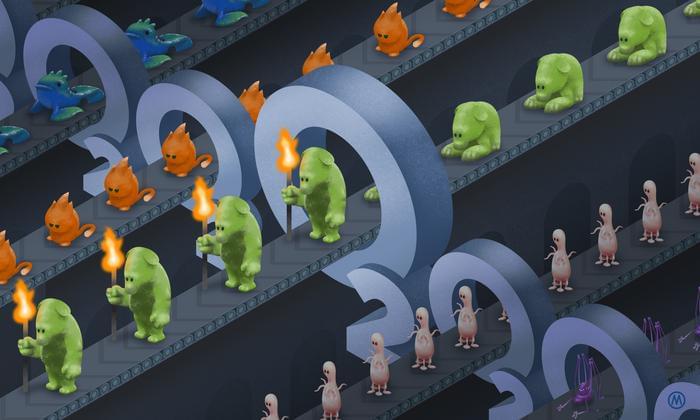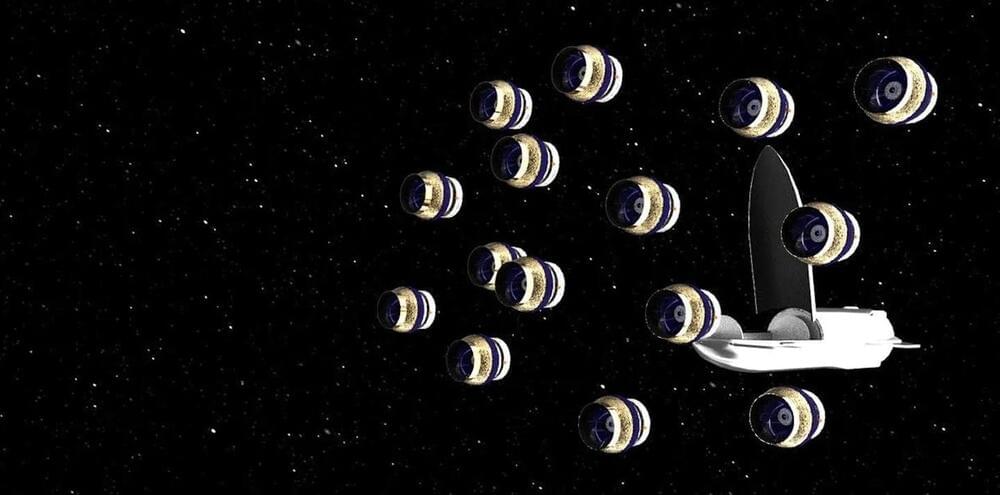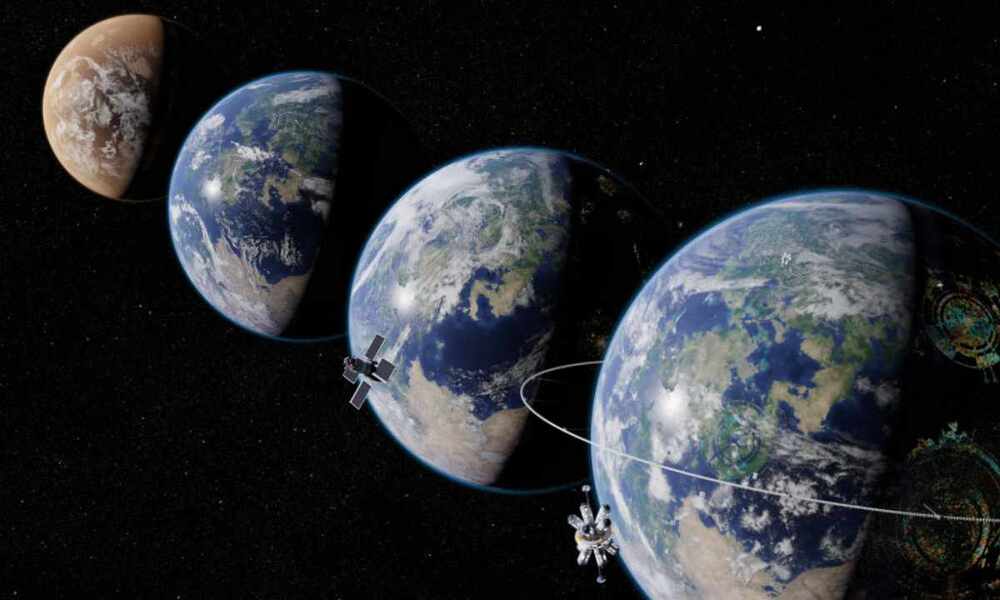The absence, not the presence, of the most important element for life in planets’ atmospheres may be what we should be seeking.



“The presence of high degrees of oxygen in the atmosphere is like a bottleneck you have to get through in order to have a technological species,” said Dr. Adam Frank.
What are the criteria for an extraterrestrial civilization to become a technological species? This is what a recent study published in Nature Astronomy hopes to figure out as a team of international researchers examine how oxygen plays a role in technological advancement, specifically pertaining to it being a necessary requirement for producing fire. This study was partially funded by a NASA grant and holds the potential to help researchers better understand the criteria for identifying technological signatures of extraterrestrial intelligence, also known as “technosignatures”
Illustration depicting how higher atmospheric oxygen levels could lead to technoligcal advancement for an extraterrestrial species, specifically pertaining to the creation of fire. (Credit: University of Rochester illustration / Michael Osadciw)
“You might be able to get biology—you might even be able to get intelligent creatures—in a world that doesn’t have oxygen, but without a ready source of fire, you’re never going to develop higher technology because higher technology requires fuel and melting,” said Dr. Adam Frank, who is Helen F. and Fred H. Gowen Professor of Physics and Astronomy at the University of Rochester and co-author on the study.

Astronomers have discovered more than 5,000 planets outside of the solar system to date. The grand question is whether any of these planets are home to life. To find the answer, astronomers will likely need more powerful telescopes than exist today.
I am an astronomer who studies astrobiology and planets around distant stars. For the last seven years, I have been co-leading a team that is developing a new kind of space telescope that could collect a hundred times more light than the James Webb Space Telescope, the biggest space telescope ever built.
Almost all space telescopes, including Hubble and Webb, collect light using mirrors. Our proposed telescope, the Nautilus Space Observatory, would replace large, heavy mirrors with a novel, thin lens that is much lighter, cheaper and easier to produce than mirrored telescopes. Because of these differences, it would be possible to launch many individual units into orbit and create a powerful network of telescopes.
Kmele steps inside Fermilab, America’s premiere particle accelerator facility, to find out how the smallest particles in the universe can teach us about its biggest mysteries.\
\
This video is an episode from @The-Well, our publication about ideas that inspire a life well-lived, created with the @JohnTempletonFoundation.\
\
Watch the full podcast now ► • Dispatches from The Well \
\
According to Fermilab’s Bonnie Flemming, the pursuit of scientific understanding is “daunting in an inspiring way.” What makes it daunting? The seemingly infinite number of questions, with their potentially inaccessible answers.\
\
In this episode of Dispatches from The Well, host Kmele Foster tours the grounds of America’s legendary particle accelerator to discover how exploring the mysteries at the heart of particle physics help us better understand some of the most profound mysteries of our universe.\
\
Read the video transcript ► https://bigthink.com/the-well/dispatc…\
\
00:00:00 — The Miracle of Birth\
00:04:48 — Exploring the Universe’s Mysteries\
00:09:20 — Building Blocks of Matter and the Standard Model\
00:13:35 — The Evolving Body of Knowledge\
00:17:39 — Understanding the Early Universe\
00:22:05 — Reflections on Particle Physics\
00:25:34 — The Extraordinary Effort to Understand the Small\
00:29:59 — From Paleontology to Astrophysics\
00:33:40 — The Importance of the Scientific Method and Being Critical\
\
\
About Kmele Foster:\
\
Kmele Foster is a media entrepreneur, commentator, and regular contributor to various national publications. He is the co-founder and co-host of The Fifth Column, a popular media criticism podcast.\
\
He is the head of content at Founders Fund, a San Francisco based venture capital firm investing in companies building revolutionary technologies, and a partner at Freethink, a digital media company focused on the people and ideas changing our world.\
\
Kmele also serves on the Board of Directors of the Foundation for Individual Rights and Expression (FIRE).\
\
\
Read more from The Well: \
Actually, neuroscience suggests “the self” is real\
► https://bigthink.com/the-well/actuall…\
Mary Shelley’s Frankenstein can illuminate the debate over generative AI\
► https://bigthink.com/the-well/mary-sh…\
Few of us desire true equality. It’s time to own up to it\
► https://bigthink.com/the-well/few-des…\
\
\
About The Well\
Do we inhabit a multiverse? Do we have free will? What is love? Is evolution directional? There are no simple answers to life’s biggest questions, and that’s why they’re the questions occupying the world’s brightest minds.\
\
Together, let’s learn from them.\
\
\
\
Join The Well on your favorite platforms:\
► Facebook: https://bit.ly/thewellFB \
► Instagram: https://bit.ly/thewellIG


The longest — and last — full moon of the year will appear on Monday night and peak on Tuesday.
December’s full moon, also known as the Cold Moon and Long Night Moon, will reach peak illumination at 7:33 p.m. ET on Tuesday, according to NASA. It will look like a full moon until Thursday morning. The Old Farmer’s Almanac details specific moonrise times for different ZIP codes across the United States.
To view the full moon, it’s not rocket science: NASA recommends going outside and looking up at the sky. Using a telescope or binoculars will magnify the moon and clarify details on its surface.

This was suggested by Gustave Fechner and other philosophers.
How about planets? Can they have minds? This idea, that planets are also conscious beings, seems to be at the heart of a new theory put forth by astrobiologists. The premise of this thought experiment is that bacteria and plants working together have altered planets like Earth, giving them a new lease on life.
This research, published in the International Journal of Astrobiology, provides a scale by which planets’ intelligence can be evaluated. It’s shocking to consider an extraterrestrial organism intelligent rather than a sentient animal like a human. But in a way, a planet can have a “green mind”; this paradigm suggests novel approaches to coping with climate change, technological upheaval, and other emergencies.
Planetary intelligence was characterised by the researchers as “cognitive activity” and knowledge functioning on a global scale. We understand that the concept of intelligence may be applied to everything from an individual to a community or even the peculiar actions of a virus or mould. For example, fungi’s webs of mycelium beneath the forest floor are its own breath; together, they make up a living system that can detect and adapt to shifting climates. All of Earth’s conditions will be drastically altered by these factors.
Researchers have had an unprecedented and exceptional encounter with a humpback whale, allowing them to learn more about humpback whale communication systems. The encounter happened earlier this year when a group of researchers known as Whale-SETI held a 20-minute “conversation” with a humpback named Twain.
The conversation is heavily detailed in a paper published in the journal Peer J and it showcases the first conversation between humans and humpback whales using “humpback language.” To pull off such a wonderful breakthrough, researchers used a recorded humpback contact call to get Twain’s attention. From there, the whale responded with a greeting signal and began to circle their boat.
Lead author Dr. Brenda McCowan from U.C. Davis says that the conversation goes a long way to emphasizing the intelligence of these creatures, and highlights how complex humpback communication systems are. The fact that they can create nets made of bubbles to catch fish, and even communicate extensively through their songs and calls is mind-boggling.
In the grandeur of the universe, the tapestry of life may be woven from stranger threads than we ever dared to dream, and spun from materials far different to our own.\
Watch my exclusive video The Fermi Paradox Hermit Shoplifter Hypothesis: https://nebula.tv/videos/isaacarthur–…\
Get Nebula using my link for 40% off an annual subscription: https://go.nebula.tv/isaacarthur\
Get a Lifetime Membership to Nebula for only $300: https://go.nebula.tv/lifetime?ref=isa…\
\
Visit our Website: http://www.isaacarthur.net\
Join Nebula: https://go.nebula.tv/isaacarthur\
Support us on Patreon: / isaacarthur \
Support us on Subscribestar: https://www.subscribestar.com/isaac-a…\
Facebook Group: / 1,583,992,725,237,264 \
Reddit: / isaacarthur \
Twitter: / isaac_a_arthur on Twitter and RT our future content.\
SFIA Discord Server: / discord \
\
Credits:\
Silicon-Based Lifeforms \
Episode 426; December 21, 2023\
Produced, Written \& Narrated by: Isaac Arthur\
Graphics: Ken York / YD Visual\
Music Courtesy of Epidemic Sound http://epidemicsound.com/creator
Have you ever wondered what the universe looked like before the first stars were born? How did these stars form and how did they change the cosmos? These are some of the questions that the James Webb Space Telescope, or Webb for short, will try to answer. Webb is the most powerful and ambitious space telescope ever built, and it can observe the infrared light from the most distant and ancient objects in the universe, including the first stars. The first stars are extremely hard to find, because their light is very faint and redshifted by the expansion of the universe. But Webb has a huge mirror, a suite of advanced instruments, and a unique orbit that allows it to detect and study the first stars. By finding the first stars, Webb can learn a lot of information that can help us understand the early history and evolution of the universe, and test and refine the theoretical models and simulations of the first stars and their formation processes. Webb can also reveal new and unexpected phenomena and raise new questions about the first stars and their role in the universe. Webb is opening a new window to the cosmic dawn, where the first stars may shine. If you want to learn more about Webb and the first stars, check out this article1 from Universe Today. And don’t forget to like, share, and subscribe for more videos like this. Thanks for watching and see you next time. \
\
Chapters:\
00:00 Introduction\
01:09 Finding the first stars\
03:21 Technical challenges and scientific opportunities\
07:18 Challenges and limitations \
10:04 Outro\
10:31 Enjoy\
\
Best Telescopes for beginners:\
Celestron 70mm Travel Scope\
https://amzn.to/3jBi3yY\
\
Celestron 114LCM Computerized Newtonian Telescope\
https://amzn.to/3VzNUgU\
\
Celestron – StarSense Explorer LT 80AZ\
https://amzn.to/3jBRmds\
\
Visit our website for up-to-the-minute updates:\
www.nasaspacenews.com\
\
Follow us \
Facebook: / nasaspacenews \
Twitter: / spacenewsnasa \
\
Join this channel to get access to these perks:\
/ @nasaspacenewsagency \
\
#NSN #webb #firststars #cosmicdawn #astronomy #space #universe #infrared #telescope #nasa #esa #science #discovery #history #evolution #reionization #chemistry #physics #light #darkness #bigbang #galaxies #blackholes #supernovae #elements #life #youtube #video #education #entertainment #information #NASA #Astronomy